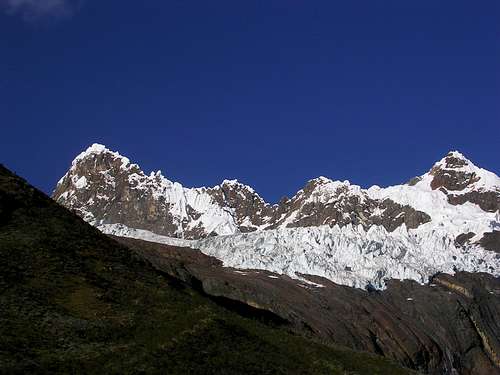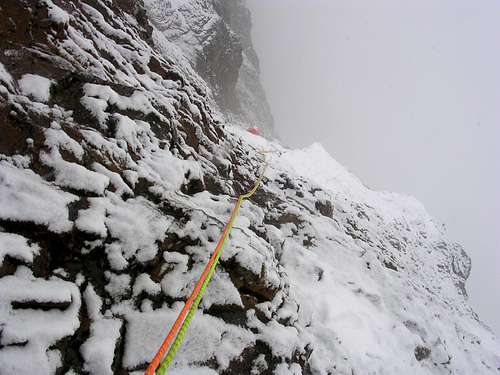Introduction
The story begins in 1989. I was reading Jim Bartle’s book “Treks of the Cordillera Blanca” and I saw a picture of Kayesh. I simply could not turn the page because it grabbed my imagination. I knew right then that were going to pass many years before I couldd climb it because I just started climbing the year before. But, nevertheless the mountain stuck deep.
On my second trip to Cordillera Blanca in 1998 I went to the high camp to take pictures of this mountain. To get up to this high camp I took, by mistake, the hardest approach possible and I ended climbing very close to the seracs; not a very wise alternative. Still more training was needed to climb it, but the dream was as intense as nine years before.
Three attempts and three years: 2001 to 2003
In 2001 I went with Chuck Claude and many things went awry. At base camp I did not boil the water, and when we arrived at the high camp I was with diarrhea. Not enough with this problem we got stormed, and we were using bivy sacks. And, to top things off I got a severe case of bronchitis. So, the decision was quite simple: go down to recover.
With Ignacio, a friend from Ecuador, we gave kayesh a go in 2002. We arrived at the bergschrund and I felt that it was not my time to climb it. I told that to Ignacio and he understood. We went back to Huaraz and decided to go to Churup.
With Luis A. Rodriguez—my old ice climbing instructor—we went in 2003. In Huaraz we found two old friends from Ecuador, Ignacio and Andres, and we decided to go in two teams to Kayesh. We arrived at the high camp and I got sick with bronchitis, again. They went up as threesome and arrived at the Italian fixed ropes on pitch 4 and came down— they felt slow. They came down the next day after 24 hours of climbing.
Almost there
![Kayesh:the bergschrund]()
This year, 2006, the story has four chapters. The first time I went with Luis and he injured his rotator cuff bouldering at the high camp. He needed to go to Huaraz to check the injury. I came down to find another partner and I found a guy that had been on Everest. It was my second time at the bergschrund and he began to have a hypothermic reaction; we could not go up. As soon as I realized this, I thought, “When I am going to be able to cross this bergschrund?”. On the third try I partenered with Abraham, a guy that had climbed Torre Central in Chile, we thought that it was a strong partnership. Surely it was, but the weather played tricks again. We crossed the bergschrund—finally—But we began to get pounded by the storm, and on top of that we were not able to retrieve our ropes after the rappel. We left the ropes for two days there and then we retrived it, but we left a 0.75 camalot that was solidly frozen at the rappel station. We came to Huaraz and Abraham was not able to change his plane ticket. He left and I began searching for another partner.
The final push
Andres, the Ecuadorean, was arriving in town. We went up. The weather was turning bad as soon as we left, and we figured out that our only chance was going to be that night. We hiked eight hours and at 8 pm we were already sleeping. We set the alarm for 2 am and I did not wake up: Andres did. We had breakfast and by three we were moving.
I lead the bergschrund and the pitch leading into the wall. Andres went the next two pitches. Then I took the lead and we arrived at the Italian ropes. He began the second crux of the day—the first one being the bergschrund— and I was day dreaming: moments later a medium-sized rock hit so close that I could smelled it. This brought me back to reality! I knew that he was leading on top of me and getting onto the traverse.
As a second I was carrying everything (both of our boots, axes, jackets, water, etc) and when I arrived at the traverse this pack felt awfully heavy. I asked him to haul it, but it was getting stuck on the protruding rocks. I untied one of my ropes and attatched it to the pack. It was quite an invigorating experience to climb a 5.10a under these conditions. I arrived at the belay panting and in need of water. I opened the pack and realized that we did not have any more water. Oh well, the pitches leading to the last headwall were mine.
![The last belay reached]()
![hit by the storm]()
I wanted to lead the last crux and be as far away from the pack as possible. I arrived at the Abalakov placed by a German team three weeks before. I thought, “only one more pitch to the headwall”. He arrived and I changed onto the leather boots— my Nepal Extremes—which I love more than anything else. As soon as I did this It began snowing quite hard. I looked at Andres and told him to put me on belay to keep going. A quite enjoyable rock climbing became an interesting mixed experience with wet rock. I had my crampons on and my ice axes dangling from my wrists and going onto wet rock and becoming quite sketchy. The last straw was the lightning that began to get closer. Right there was going to be our highest point. I did not want to go higher for two reasons. First, we were approaching the ridge and lightning loves ridges. Second, the next crux was 5.10a and in the prevailing conditions was going to be a desperate pursuit. We went down for 5 hours in the storm. I was thinking about Jim Morrison’s song “Raiders on the storm” meanwhile we were rapping off. The rope got stuck twice. The first time was easy to retrieve it, but the second time was another story. It took me two hours to get the rope unstuck. I was so dehydrated that pulling the rope was an Herculean task almost beyond me. We arrived at base camp 26 hours after leaving it.
![More good weather]()












Comments
Post a Comment